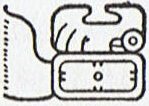On the other side of the 'Tree' the 'land' could be different. In Ca6-16 we can imagine the 'grasping hand' - Mayan chikin, Metoro's tagata oho rima (person going to 'the hand') - at the horizon in the west. There are 13 'notches' (Spanish for nights) at left, and 12 * 13 = 156:
The old Roman calendar could be of use for us. Therefore I have below added the dates half a year later (= earlier), and tried to count with August 25 'translated' into February 24: ... Once again, glyph 157 could be pointing at the day which is the first beyond number 92 + 40 + 24 after March 21. South of the equator this season is not at the end of high summer but instead corresponding to 40 + 24 + 1 = 65 days after winter solstice, or around day 355 + 65 = 420. This should be February 24 (55) or - if we should consider the day when Castor rose heliacally as a leap day - February 23 (54) ...
The results are encouraging. September 29 (272) is 182 days later than March 31 (90) and here the text has an extraordinary glyph with figures inside. We have earlier found April 1 to be a very special date at the end of side b on the H tablet:
In rongorongo times February 23 could be connected with Castor, because it was the date of the midnight culmination of his star:
The creator of the Moon calendar in C could have intended it to begin 384 days after May 25 (because 13 * 29½ = 383½ is a fact which probably explains why Gb5-29 is only 'half' a glyph). February 18 (at hakaariki in Gb5-28 where the glyph number agrees with the synodical cycle of Saturn) maybe should be compared with the glyph which in C comes 384 - 378 = 6 days earlier than Ca6-17 (157):
| |||||||||||||||||||||||||||||||||||||||||||||||||||||||||||||||||||||||||||||||||||||||||||||||||||||||||||||||||||||||||||||||||||||||||||||||||||||||||||||||||||||||||||||||||||||||||||||||||||||||||||||||||||||||||||||||||||||||||||||||||||||||||||||||||||||||||||||||||||||||||||||||||||||||||||||||||||||||||||||||||||||||||||||||||||||||

























